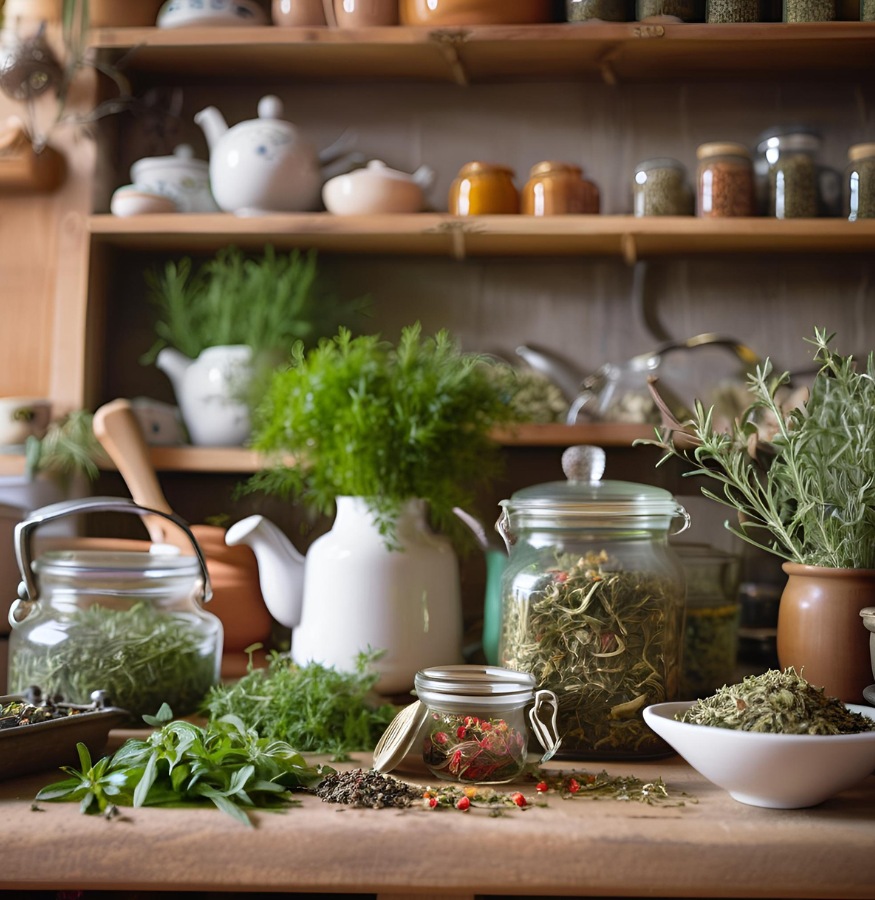Master the Art of Herbs and Teas: Essential Tips for Selection, and Brewing

Herb and Tea Essentials
Herbs and teas have been cherished for centuries, not just for their flavors but also for their medicinal properties. Herbs are plant-based ingredients, often dried leaves, flowers, or roots, used to enhance health and wellness. Teas, a subset of herbal infusions, can be made from the leaves of the Camellia sinensis plant or various herbs and botanicals.
The popularity of herbal remedies and tea culture is on the rise. People are increasingly turning to natural alternatives for health benefits and savoring the ritual of brewing a perfect cup of tea. The experience is both soothing and enriching.
Key takeaway: This article will guide you on how to select the best herbs and teas, store them properly for long-lasting freshness, and master the art of brewing the perfect cup.
Quality ingredients and proper techniques are essential for an exceptional herbal tea experience. Using fresh, high-quality herbs ensures that your tea is flavorful and retains its beneficial properties. Proper brewing techniques unlock the full potential of these ingredients, delivering a cup that is both delightful and beneficial.
No time like the present. Let's get started!
1. Selecting High-Quality Herbs and Teas
The quality of herbs and teas significantly impacts their taste and medicinal properties. High-quality ingredients provide a richer flavor and more potent health benefits.
Freshness, Aroma, and Appearance: The Trifecta of Herb Selection
When selecting herbs:
- Freshness: Look for vibrant colors and firm textures. Avoid herbs that are wilted or discolored.
- Aroma: Fresh herbs should have a strong, distinct smell. If the scent is faint or off, the herb may be past its prime.
- Appearance: Choose herbs with intact leaves and stems. Broken or damaged parts can indicate poor quality.
Flavor Profiles and Caffeine Content: Decoding Tea Labels
Tea labels often give insights into their flavor profiles and caffeine content:
- Flavor Profiles: Understand the basic categories like floral, fruity, earthy, or spicy to match your taste preferences.
- Caffeine Content: Teas range from high-caffeine options like black tea to caffeine-free herbal teas. Choose according to your sensitivity and preference.
The Advantages of Opting for Organic Varieties
Organic herbs and teas offer numerous advantages:
- No Pesticides: Organic products are grown without harmful chemicals, making them safer for consumption.
- Better Taste: Many find that organic varieties have a purer, more robust flavor.
- Environmental Impact: Supporting organic farming practices contributes to sustainable agriculture.
Selecting high-quality herbs and teas enhances both the sensory experience and health benefits of your brews.
2. Storing Herbs and Teas for Longevity
Proper storage is essential to maintain the potency of herbs and the freshness of tea leaves. Exposure to light, heat, and moisture can degrade the quality of your herbal collections, reducing both their flavor and medicinal benefits.
Keeping it Fresh: Tips for Storing Bulk Herbs
- Airtight Containers: Use well-sealed glass jars to keep air out and preserve the aroma and effectiveness of bulk herbs.
- Cool, Dark Places: Store your containers in a cool, dark area to protect them from light and temperature fluctuations.
- Labeling: Always label your jars with the name of the herb and the date of storage to keep track of freshness.
From Leaves to Infusions: Best Practices for Tea Storage
- Sealed Packaging: Keep tea leaves in airtight containers or resealable bags to prevent exposure to air and moisture.
- Avoiding Strong Odors: Store teas away from strong-smelling items like spices or cleaning products, as they can absorb odors.
- Consistent Environment: Aim for a stable environment with minimal temperature changes to maintain the quality of your tea.
These practices ensure that both herbs and teas retain their optimal flavors and health benefits over time.
3. Drying Herbs: Methods and Preservation Techniques
Benefits of Drying Your Own Herbs
Drying herbs at home ensures you have a ready supply of fresh, aromatic ingredients for your teas. This method offers several benefits:
- Control Over Quality: You can select the freshest herbs, ensuring maximum potency.
- Cost-Effective: Home-dried herbs are more economical than store-bought versions.
- Customized Blends: Create unique herbal mixes tailored to your taste and needs.
Air Drying, Oven Drying, and Other Methods Explained
Different drying techniques can be employed to preserve herbal freshness, each with its advantages:
- Air Drying: Ideal for most herbs. Bundle small bunches of herbs together using string or rubber bands. Hang them upside down in a warm, well-ventilated area away from direct sunlight.
- Oven Drying: Suitable for quicker results. Spread the herbs on a baking sheet and dry at the lowest oven temperature (around 100°F/38°C) for 2-4 hours. Keep the oven door slightly ajar to allow moisture to escape.
- Dehydrator: A specialized tool that provides consistent results. Place the herbs on dehydrator trays and set the temperature between 95°F to 115°F (35°C to 46°C).
Preserving the Flavor and Aroma of Dried Herbs
To maintain the integrity of dried herbs, follow these tips:
- Store in Airtight Containers: Use glass jars with tight-fitting lids.
- Keep in a Cool, Dark Place: Exposure to light and heat can degrade the quality.
- Label and Date: Ensure you know when they were dried to use them within optimal time frames.
By mastering these methods, you ensure your dried herbs retain their essential oils and flavors, enhancing your tea experience consistently.
4. The Art of Tea Brewing
Understanding the Basics: Water Temperature and Steeping Time
Mastering the basics of tea brewing starts with understanding water temperature and steeping time. Different teas require specific temperatures to unlock their full flavor profiles:
- Green Tea: 70-80°C (158-176°F) for 2-3 minutes.
- Black Tea: 90-100°C (194-212°F) for 3-5 minutes.
- Herbal Teas: 100°C (212°F) for 5-7 minutes.
Using the wrong temperature or steeping for too long can make the tea taste bitter or harsh, which takes away from its quality.
Unleashing Flavors: Different Techniques for Various Types of Tea
There are different ways to brew tea that can bring out its flavors even more:
- Gongfu Cha: This is a traditional Chinese method that uses small teapots, multiple quick infusions, and high-quality tea leaves.
- Western Method: This method is commonly used in everyday situations and involves larger teapots with longer steeping times.
- Cold Brew: Instead of using hot water, you can steep tea leaves in cold water for a longer period of time (usually overnight). This results in a smoother and less bitter taste.
Each technique offers its own unique flavors and can be chosen based on what you like or the type of tea you're brewing.
Experimentation and Personalization: Making Your Perfect Cup of Tea
The best way to find your ideal cup of tea is through experimentation. Here are some things you can try adjusting:
- Amount of Tea Leaves: Using more leaves will make the tea stronger.
- Steeping Time: Leaving the tea in hot water for a longer time will release more flavors, but it may also make the taste more bitter.
- Additions: You can enhance your tea by adding lemon, honey, mint, or spices according to your preference.
By personalizing your tea, you can create a drink that suits your taste perfectly. Don't be afraid to try out different combinations and brewing methods to see what you like the most.
5. Taking It Further: Exploring New Possibilities
Enhancing Food and Health with Dried Herbs
Dried herbs have endless potential beyond a simple cup of tea. They can be used in various ways to elevate your culinary creations and improve your well-being:
- Culinary Delights: Add depth and complexity to your dishes by incorporating dried rosemary, thyme, or oregano into soups, stews, and roasted meats.
- Soothing Remedies: Create herbal sachets with lavender and chamomile to promote relaxation and better sleep.
Unleashing the True Potential of Tea: Advanced Brewing Techniques
If you're a tea lover looking to delve deeper into the world of tea, here are some advanced brewing methods worth exploring:
- Chinese Tea with Gaiwan: Experience the traditional way of brewing Chinese teas using a gaiwan, a lidded bowl that allows for multiple infusions and brings out the nuanced flavors.
- Russian Blends with Samovar: Dive into the rich culture of Russian teas by using a samovar, a heated metal container, to brew strong and robust blends.
- Smooth and Refreshing Cold Brew: Beat the summer heat with cold brewing, a method that involves steeping tea leaves in cold water for several hours to extract a milder yet refreshing taste.
Unleashing Your Creativity: Blending Flavors and Crafting Tea Concoctions
Don't be afraid to think outside the box and experiment with different combinations! Here are some ideas to get you started:
- Minty Fresh Twist: Combine peppermint with chocolate mint for a refreshing and invigorating flavor fusion.
- Fruity Floral Elixir: Mix chamomile with dried fruit for a delightful and aromatic beverage that calms both the body and mind.
- Spiced Infusion: Use spices like cinnamon or cardamom to add warmth and complexity to your teas.
By effectively using dried herbs and exploring advanced brewing techniques, you can take your tea experience to new heights. These tips open up endless possibilities for tea enthusiasts like you to enjoy your favorite beverage in innovative ways.
Embrace Your Journey as an Herbalist and Tea Connoisseur
Mastering the art of herbs and teas is a continuous and rewarding journey. Enjoy the process of learning and experimenting with different herbs and teas. Everyone has different taste preferences, so don't hesitate to try new combinations and discover what uniquely satisfies your palate.

